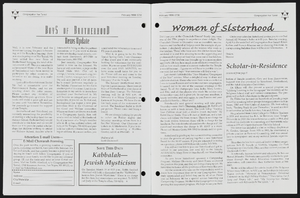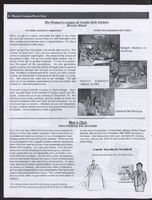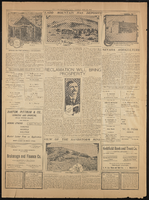Search the Special Collections and Archives Portal
Search Results
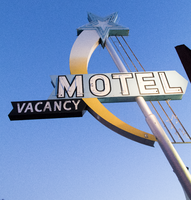
Photographs of Star Motel sign, Las Vegas (Nev.), March 3, 2017
Date
Archival Collection
Description
Site address: 1418 S 3rd St
Sign owner: M V Star Group LLC
Sign details: 0.33 acre lot, originally constructed in 1947.
Sign condition: 4 - The sign is in excellent condition, but it does not light up at night.
Sign form: Pole sign
Sign-specific description: The sign itself is attached to a silver pole that extends out toward 3 rd St and is planted into the ground. On the top of the pole is a bright, blue star with a smaller white star in the center. The neon tubes attached to the sign are in concentric star shapes radiating out from the center. Extending out from the star to 3 rd st and curving back towards the pole that hold the sign is a trail implying that this is a shooting star. The first third of this trail is white and then the paint changes to yellow and remains yellow for the rest of the trail. The entire trail of the star is covered with yellow incandescent light bulbs. There are three very thin steel poles on the opposite side of the star from where the trail is attached. These smaller poles run parallel to the main pole of the sign and end about the same place where the tail of the star ends at the other side of the pole. Attached to these thin poles are stars ranging in size and made out of neon tubes. About at the midpoint of the main pole supporting the sign is a minimal, bright blue arrow that has "MOTEL" painted on it in bold white letters with a black outline. Neon tubes in the shape of each letter are attached to the center of the letters. Attached to the bottom of the tail end of this arrow is a smaller, minimal, black arrow that has "VACANCY" painted on it in bold white letters. Neon tubes in the shape of these letters fill this sign as well.
Sign - type of display: Neon and Incandescent
Sign - media: Steel
Sign animation: Unknown, as it no longer lights. However according to RoadArch.com, at one time it might have flashed.
Sign environment: The property is in the heart of the Arts District. It resides next to many other small motels in this neighborhood. It is only a few blocks away from Main Street and Charleston where there are many art galleries, restaurants, and vintage boutiques.
Sign - date of installation: c. 1950s
Sign - date of redesign/move: Based on earlier photographs from the 1950's, the sign's main star that is blue with a smaller white star in the center was originally all white. Also, the white and yellow trail it leaves behind was initially all yellow as well. It is also believed that there were more stars attached to the metal bars that extend from the blue and white star and that they would have flashed.
Sign - thematic influences: A popular theme for properties during this time was the Space Age and this is sign is an example of that influential theme.
Sign - artistic significance: This sign shows an influence of the Space Age that was going on during the late 50's. Many motel signs in the city evoked the theme for the property and this sign does so for the Star Motel.
Survey - research locations: Assessor's website, Vintage Vegas, www.roadarch.com
Surveyor: Lauren Vaccaro
Survey - date completed: 2017-08-21
Sign keywords: Neon; Incandescent; Steel; Pole sign
Mixed Content
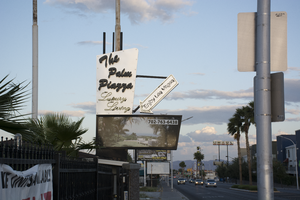
Photographs of The Palm Piazza sign, Las Vegas (Nev.), April 18, 2017
Date
Archival Collection
Description
Site address: 1919 Fremont St
Sign owner: Zen Real Estate Holding
Sign details: This building dates back to 1936 and was made for commercial living accommodations/ deluxe motel. Previous to the Palm Piazza opening this location was called the Ariza Motel which was abandoned for a few years. Kamran Foulad in 2013 purchased this building to renovate it in an effort to revitalize downtown. The Palm Piazza opened as an apartment complex in late 2013.
Sign condition: 4- slight fading but still in good condition
Sign form: Pylon
Sign-specific description: There is a black base of the sign that is not very tall which holds a back lit plastic sign that has an image of a lady under a palm-tree leaf canopy and the location's phone number in black numbers. Above this is a blue steel backing that in the shape of a sideways trapezoid which is about half of the width of the black sign beneath it (and is laid on the building side of the sign). This portion has black back lit plastic letters that spell out "The Palm Piazza" in a bubbly cursive font towards the top of the sign. Then below this in yellow skeletal neon tubes they have "Luxury Living" spelled out in a thin tight cursive font. On the road side of the sign there is an arrow blue steel arrow that points down towards the black portion of the sign. The arrow is outlined in yellow neon tubes and has "Enjoy Las Vegas" in clear print font skeletal neon tubes.
Sign - type of display: Neon and back lit plastic signs
Sign - media: Steel and plastic
Sign - non-neon treatments: Plastic portion of the sign
Sign environment: This area is located East Fremont close to Bruce Street. There are other motels surrounding this area.
Sign - date of installation: This sign has been up in form that we see today in 2013, though it looks as though they re-purposed/redesigned the sign that the Ariza Motel (previous property name) had. The previous sign has been up since at least 2007.
Sign - date of redesign/move: 2013- Ariza Motel blade taken down and the rest of the sign redesigned for the Palm Piazza.
Sign - thematic influences: Previous to the apartment complex it was a motel and their signs still has remnants of that 1950/60's motel sign design particularly with the arrow.
Survey - research locations: Assessor's Page, Review Journal article discussing the renovation of the building https://www.reviewjournal.com/local/local-las-vegas/developer-eyeing-overlooked-las-vegas-downtown-area-gets-city-boost/, Google map sattelite/ roadside view
Survey - research notes: On the top portion of the blue steel sign there are 3 short black steel beams coming out of it which used to hold an old MOTEL blade sign which was taken down around 2013.
Surveyor: Emily Fellmer
Survey - date completed: 2017-09-09
Sign keywords: Neon; Backlit; Plastic; Steel; Pole sign
Mixed Content

Bluebell Girls: scrapbook of newspaper clippings and photographs
Date
Archival Collection
Description
From the Margaret Kelly Collection on the Bluebell Girls, MS-00604. The scrapbook includes newspaper clippings about the Bluebell Girls, Folies-Bergère, and dancer Catherine Dunne's experiences in Milan, Italy at the start of World War II.
Mixed Content
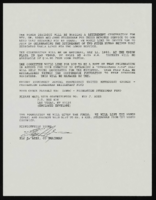
Mabel Hoggard: religious materials
Date
Archival Collection
Description
Folder of materials from the Mabel Hoggard Papers (MS-00565) -- Personal papers file. This file contains religious booklets, programs, newspaper clippings, and other documents. Represented in the materials are records from: Griffith United Methodist Church, Church Women United of Greater Las Vegas, Zion Methodist Church, Clark County Protestant Ministerial Association, and Desert Southwest Conference of the United Methodist Church.
Mixed Content

University of Nevada, Las Vegas (UNLV) 40th commencement program
Date
Archival Collection
Description
Commencement program from University of Nevada, Las Vegas Commencement Programs and Graduation Lists (UA-00115).
Text

Leonard M. Jessup interview, August 6, 2018: transcript
Date
Description
“I decided to just keep going, and I devoted my career to higher ed. I wanted to continue putting back into this system that I felt I got a lot out of. Again, repaying a debt.” What began as a passion for playing school sports would later lead Dr. Len Jessup on a path to lifelong service in the area of higher education. From his California childhood he would soon find himself across different U.S. states performing various higher education duties from professor to university president. In this interview, Jessup talks about his grandparents’ decision to emigrate from Italy to the U.S. and how grateful he feels towards his family as a result. He recalls playing baseball in college. In his eyes, being part of several sports teams helped him develop into the person he is now. He describes doing research during at the University of Arizona and speaks to what it was like moving from one university position to the next. Ultimately, his colleagues would recommend that he move to Las Vegas to
Text

Transcript of interview with Sam Earl by Laura Button, March 9, 1981
Date
Archival Collection
Description
On March 9, 1981, Laura Button interviewed Sam Earl (born 1912 in Virgin, Utah) about his life in Nevada. Also present during the interview is Sam’s wife, Melissa Earl. The three discuss a wide range of topics from the early development of Las Vegas, Sam’s work on the Boulder Dam, the Earls’ early residence in a tent, and the family’s religious participation. The interview also covers gambling, Block 16, the first members of the police force, recreational activities, and the Helldorado parade. Sam also talks about his work as a building contractor, including some of the buildings and casino properties he helped build, and the interview moves to a discussion of the development of the Las Vegas Strip. The interview concludes with Sam’s description of his work as a truck driver and a discussion on welfare benefits.
Text

